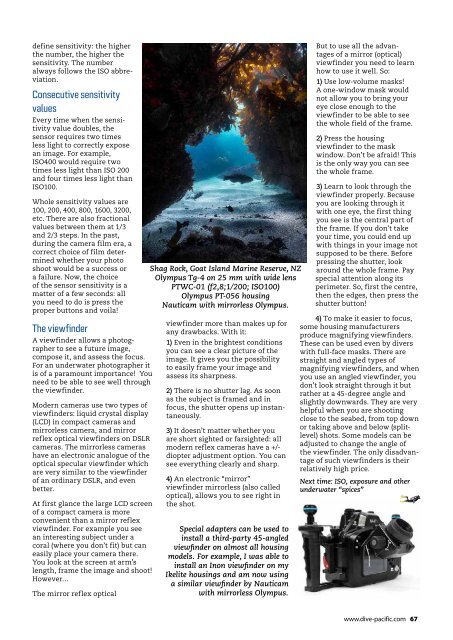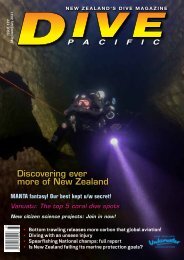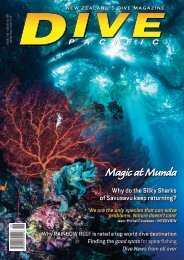Dive Pacific Iss 171 Oct- Nov 2019
New Zealand's dive magazine featuring in this issue: Shooting big sharks, up close; Spearfishing at night!; Remembering a great Kiwi dive pioneer, Wade Doak; Forgotten Vanuatu wreck's claim to fame; The invasive Lionfish - in depth, plus all our expert columnists
New Zealand's dive magazine featuring in this issue: Shooting big sharks, up close; Spearfishing at night!; Remembering a great Kiwi dive pioneer, Wade Doak; Forgotten Vanuatu wreck's claim to fame; The invasive Lionfish - in depth, plus all our expert columnists
You also want an ePaper? Increase the reach of your titles
YUMPU automatically turns print PDFs into web optimized ePapers that Google loves.
define sensitivity: the higher<br />
the number, the higher the<br />
sensitivity. The number<br />
always follows the ISO abbreviation.<br />
Consecutive sensitivity<br />
values<br />
Every time when the sensitivity<br />
value doubles, the<br />
sensor requires two times<br />
less light to correctly expose<br />
an image. For example,<br />
ISO400 would require two<br />
times less light than ISO 200<br />
and four times less light than<br />
ISO100.<br />
Whole sensitivity values are<br />
100, 200, 400, 800, 1600, 3200,<br />
etc. There are also fractional<br />
values between them at 1/3<br />
and 2/3 steps. In the past,<br />
during the camera film era, a<br />
correct choice of film determined<br />
whether your photo<br />
shoot would be a success or<br />
a failure. Now, the choice<br />
of the sensor sensitivity is a<br />
matter of a few seconds: all<br />
you need to do is press the<br />
proper buttons and voila!<br />
The viewfinder<br />
A viewfinder allows a photographer<br />
to see a future image,<br />
compose it, and assess the focus.<br />
For an underwater photographer it<br />
is of a paramount importance! You<br />
need to be able to see well through<br />
the viewfinder.<br />
Modern cameras use two types of<br />
viewfinders: liquid crystal display<br />
(LCD) in compact cameras and<br />
mirrorless camera, and mirror<br />
reflex optical viewfinders on DSLR<br />
cameras. The mirrorless cameras<br />
have an electronic analogue of the<br />
optical specular viewfinder which<br />
are very similar to the viewfinder<br />
of an ordinary DSLR, and even<br />
better.<br />
At first glance the large LCD screen<br />
of a compact camera is more<br />
convenient than a mirror reflex<br />
viewfinder. For example you see<br />
an interesting subject under a<br />
coral (where you don’t fit) but can<br />
easily place your camera there.<br />
You look at the screen at arm’s<br />
length, frame the image and shoot!<br />
However…<br />
The mirror reflex optical<br />
Shag Rock, Goat Island Marine Reserve, NZ<br />
Olympus Tg-4 on 25 mm with wide lens<br />
PTWC-01 (f2,8;1/200; ISO100)<br />
Olympus PT-056 housing<br />
Nauticam with mirrorless Olympus.<br />
viewfinder more than makes up for<br />
any drawbacks. With it:<br />
1) Even in the brightest conditions<br />
you can see a clear picture of the<br />
image. It gives you the possibility<br />
to easily frame your image and<br />
assess its sharpness.<br />
2) There is no shutter lag. As soon<br />
as the subject is framed and in<br />
focus, the shutter opens up instantaneously.<br />
3) It doesn’t matter whether you<br />
are short sighted or farsighted: all<br />
modern reflex cameras have a +/-<br />
diopter adjustment option. You can<br />
see everything clearly and sharp.<br />
4) An electronic “mirror”<br />
viewfinder mirrorless (also called<br />
optical), allows you to see right in<br />
the shot.<br />
Special adapters can be used to<br />
install a third-party 45-angled<br />
viewfinder on almost all housing<br />
models. For example, I was able to<br />
install an Inon viewfinder on my<br />
Ikelite housings and am now using<br />
a similar viewfinder by Nauticam<br />
with mirrorless Olympus.<br />
But to use all the advantages<br />
of a mirror (optical)<br />
viewfinder you need to learn<br />
how to use it well. So:<br />
1) Use low-volume masks!<br />
A one-window mask would<br />
not allow you to bring your<br />
eye close enough to the<br />
viewfinder to be able to see<br />
the whole field of the frame.<br />
2) Press the housing<br />
viewfinder to the mask<br />
window. Don’t be afraid! This<br />
is the only way you can see<br />
the whole frame.<br />
3) Learn to look through the<br />
viewfinder properly. Because<br />
you are looking through it<br />
with one eye, the first thing<br />
you see is the central part of<br />
the frame. If you don’t take<br />
your time, you could end up<br />
with things in your image not<br />
supposed to be there. Before<br />
pressing the shutter, look<br />
around the whole frame. Pay<br />
special attention along its<br />
perimeter. So, first the centre,<br />
then the edges, then press the<br />
shutter button!<br />
4) To make it easier to focus,<br />
some housing manufacturers<br />
produce magnifying viewfinders.<br />
These can be used even by divers<br />
with full-face masks. There are<br />
straight and angled types of<br />
magnifying viewfinders, and when<br />
you use an angled viewfinder, you<br />
don’t look straight through it but<br />
rather at a 45-degree angle and<br />
slightly downwards. They are very<br />
helpful when you are shooting<br />
close to the seabed, from top down<br />
or taking above and below (splitlevel)<br />
shots. Some models can be<br />
adjusted to change the angle of<br />
the viewfinder. The only disadvantage<br />
of such viewfinders is their<br />
relatively high price.<br />
Next time: ISO, exposure and other<br />
underwater “spices”<br />
www.dive-pacific.com 67













